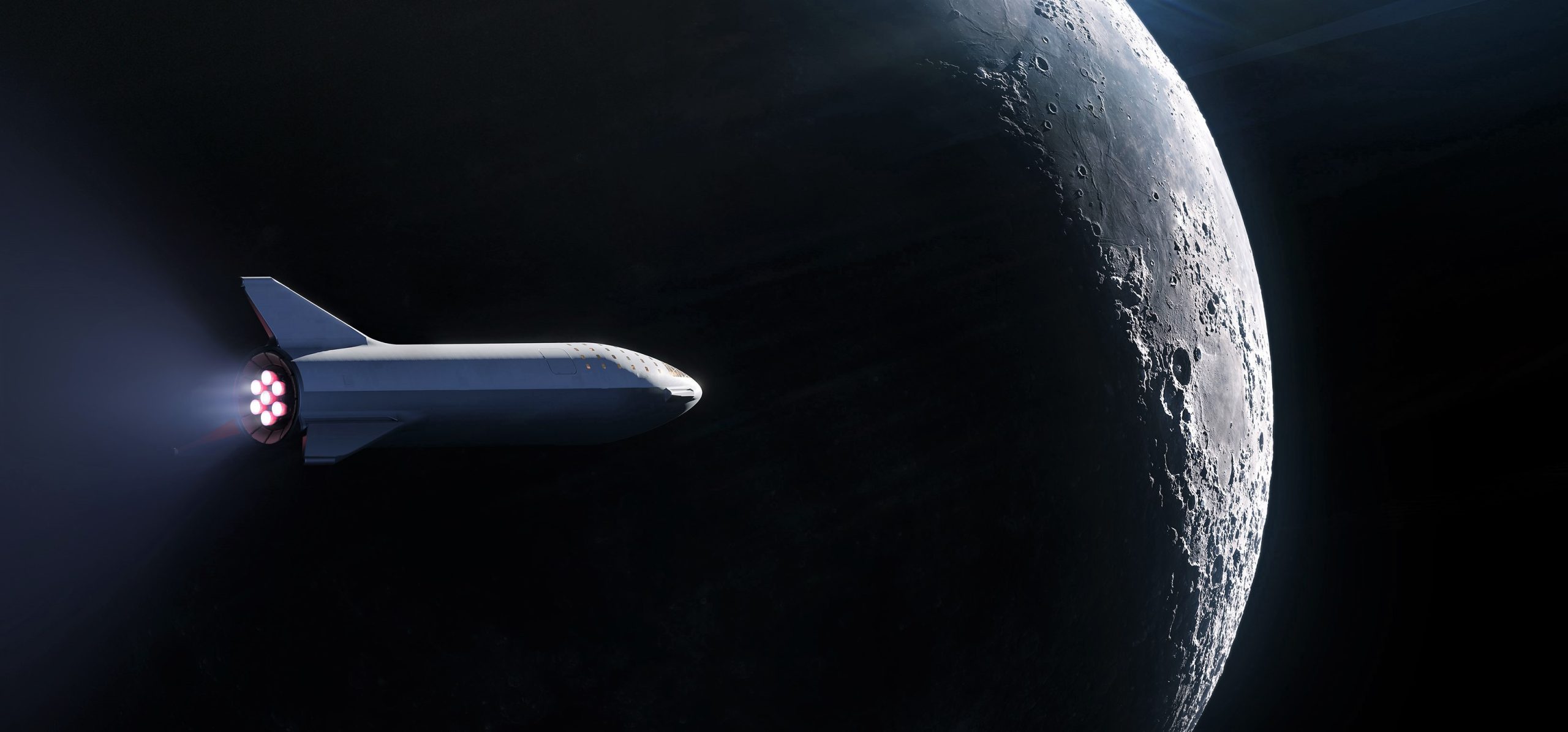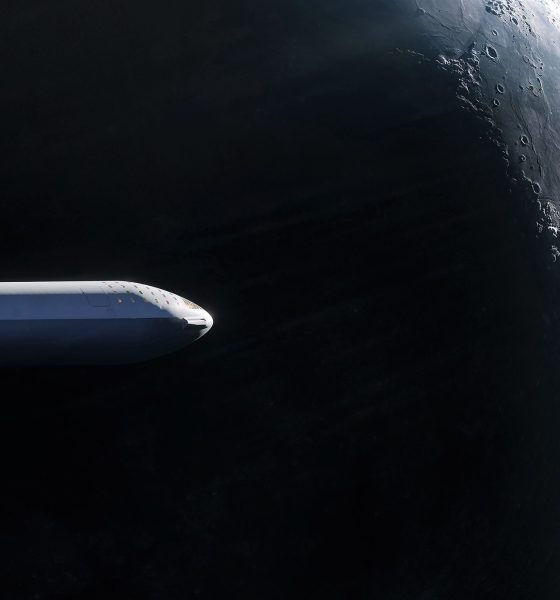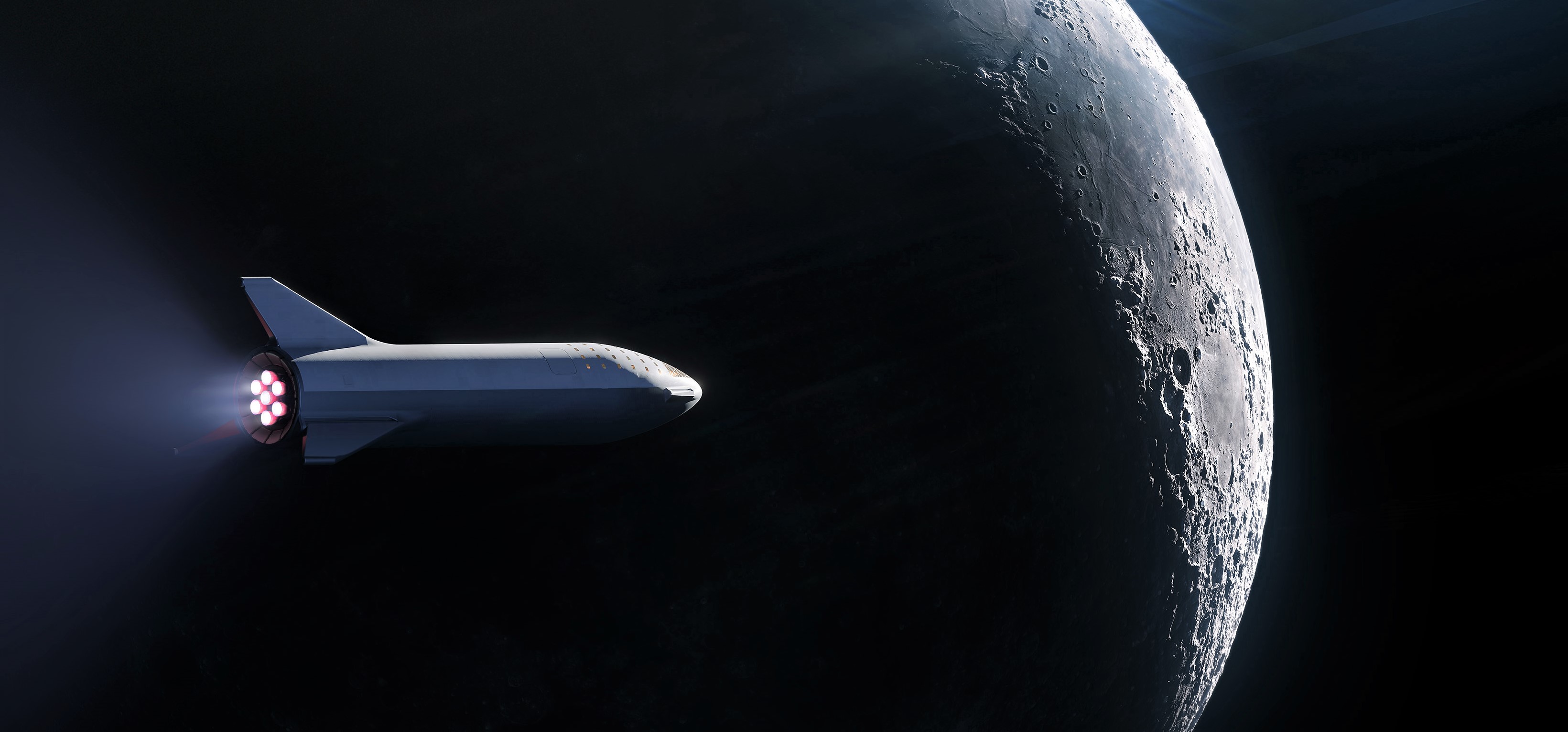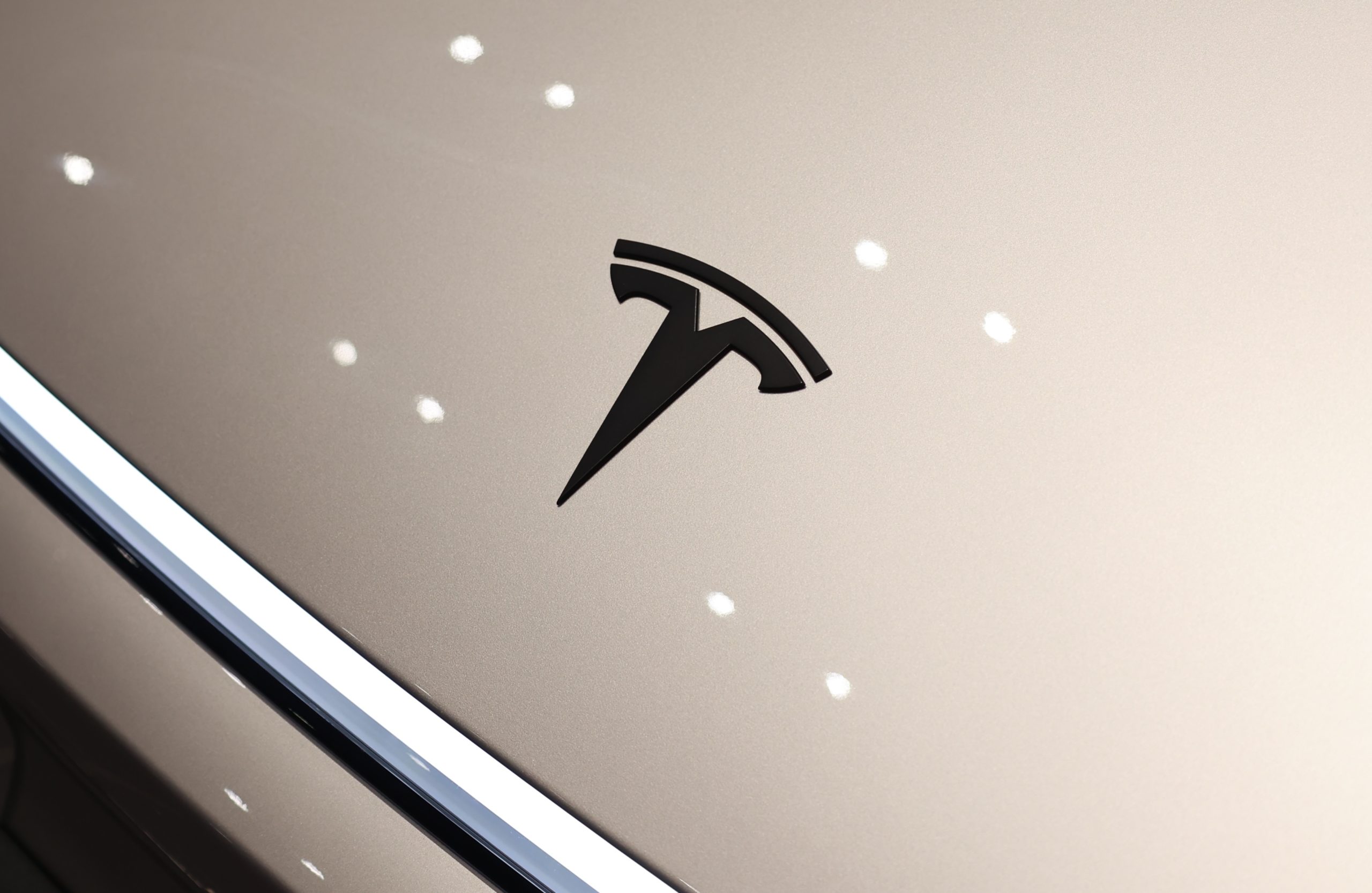

News
SpaceX to give BFR update and announce a private Moon mission on Monday
SpaceX is set for a surprise event that is expected to revolve the announcement of a newly-contracted launch planned to send a private individual around the Moon with BFR, potentially queuing up a true race (back) to the Moon between SpaceX and NASA sometime in the early to mid-2020s.
Alongside the official announcement and a fascinating render revealing a dramatically-updated iteration of BFR’s spaceship upper stage, CEO Elon Musk cryptically hinted on Twitter that the private customer could be Japanese, as well as confirming that the spaceship as shown was indicative of a new BFR design.
We’re going to the Moon, people! What I wouldn’t give to be this passenger… https://t.co/11ahm2LhE8
— Darby Dunn (@RocketJoy) September 14, 2018
Most importantly, at least for anyone eager to learn more, SpaceX will be hosting an official webcast of the announcement, NET 6:00 pm PDT on Monday, September 17th (01:00 UTC, Sept 18). Given the extreme rarity of streamed SpaceX updates unrelated to launches, as well as the fact that all of those updates have been presented by Elon Musk, it’s safe to expect that this particular update will be no different.
With any luck, this announcement may actually be the BFR update Musk teased on Twitter in mid-July, and his quoted “in a month or so” ETA meshes well with an actual update roughly two months later, Musk-time accounted for. It’s also possible that this newly-announced space tourism contract is directly related to a similar announcement made in 2017 that would have instead launched “two private customers” around the Moon with Falcon Heavy and Crew Dragon – SpaceX’s official press release noted that both of those customers had “paid a significant deposit”.
- Falcon Heavy visualized launching a Dragon 2 spacecraft, either Red Dragon or a circumlunar tourist mission (both now defunct). (SpaceX)
- SpaceX’s BFR booster seen landing back at a heavily-upgraded Pad 39A as a Crew Spaceship (left) awaits its ride to orbit. (SpaceX)
Prior to Falcon Heavy’s launch debut in February 2018, Musk offered a new perspective on human missions with Falcon Heavy, stating that SpaceX had made an internal decision to skip over a human-rated Falcon Heavy and head directly for BFR, citing his feeling that development of the next-gen rocket was proceeding quite smoothly.
“What we decided internally is to focus our future efforts on BFR. If that ends up taking longer than expected, then we’ll return to the idea of sending a Crew Dragon on Falcon Heavy around the Moon. But right now it looks like BFR development is moving quickly and it will not be necessary to qualify Falcon Heavy for crewed spaceflight.” – Elon Musk, 5 February 2018
Discussed last week, the render SpaceX published alongside this fresh announcement featured a new variant of BFR, suggesting that the company is still iterating on the spaceship’s design. This helps to explain a roughly 6-12 months schedule delay for prototype spaceship hop tests and a full BFR’s first orbital mission, slipping slightly from NET H1 2019 (hops) and 2020 (orbit) to late-2019 and 2021, respectively.

Still, it’s believed that SpaceX is already building composite propellant tank and structural prototypes in a temporary tent set up at Port of Los Angeles, evidenced by massive stacks of boxes of materials (some empty and some not) necessary for composite manufacturing (prepreg, resin, industrial HVAC, etc.). Raptor, the critical propulsion system that will power both booster and spaceship, was said by Tom Mueller – VP of Propulsion Engineering – to have all but completed prototype Raptor testing, with eyes now on building and testing engines optimized for flight. Located in the Port of LA, a dedicated BFR factory is in the early stages of construction, and completion of the first phase (a smaller factory floor) could happen sometime between Q2 and Q4 2019.
Catch the event live at the webcast below and stay tuned for Teslarati’s on-site coverage.
For prompt updates, on-the-ground perspectives, and unique glimpses of SpaceX’s rocket recovery fleet check out our brand new LaunchPad and LandingZone newsletters!

News
Tesla (TSLA) receives positive outlook and $551 PT from Canaccord Genuity
He also maintained a “Buy” rating for TSLA stock over the company’s improving long-term outlook, which is driven by autonomy and robotics.

Canaccord Genuity analyst George Gianarikas raised his Tesla (NASDAQ:TSLA) price target from $482 to $551. He also maintained a “Buy” rating for TSLA stock over the company’s improving long-term outlook, which is driven by autonomy and robotics.
The analyst’s updated note
Gianarikas lowered his 4Q25 delivery estimates but pointed to several positive factors in the Tesla story. He noted that EV adoption in emerging markets is gaining pace, and progress in FSD and the Robotaxi rollout in 2026 represent major upside drivers. Further progress in the Optimus program next year could also add more momentum for the electric vehicle maker.
“Overall, yes, 4Q25 delivery expectations are being revised lower. However, the reset in the US EV market is laying the groundwork for a more durable and attractive long-term demand environment.
“At the same time, EV penetration in emerging markets is accelerating, reinforcing Tesla’s potential multi‑year growth runway beyond the US. Global progress in FSD and the anticipated rollout of a larger robotaxi fleet in 2026 are increasingly important components of the Tesla equity story and could provide sentiment tailwinds,” the analyst wrote.
Tesla’s busy 2026
The upcoming year would be a busy one for Tesla, considering the company’s plans and targets. The autonomous two-seat Cybercab has been confirmed to start production sometime in Q2 2026, as per Elon Musk during the 2025 Annual Shareholder Meeting. Apart from this, Tesla is also expected to unveil the next-generation Roadster on April 1, 2026. Apart from this, Tesla is expected to start high-volume production of the Tesla Semi in Nevada next year.
Apart from vehicle launches, Tesla has expressed its intentions to significantly ramp the rollout of FSD to several regions worldwide, such as Europe. Plans are also underway to launch more Robotaxi networks in several more key areas across the United States.
News
Waymo sues Santa Monica over order to halt overnight charging sessions
In its complaint, Waymo argued that its self-driving cars’ operations do not constitute a public nuisance, and compliance with the city’s order would cause the company irreparable harm.

Waymo has filed a lawsuit against the City of Santa Monica in Los Angeles County Superior Court, seeking to block an order that requires the company to cease overnight charging at two facilities.
In its complaint, Waymo argued that its self-driving cars’ operations do not constitute a public nuisance, and compliance with the city’s order would cause the company irreparable harm.
Nuisance claims
As noted in a report from the Los Angeles Times, Waymo’s two charging sites at Euclid Street and Broadway have operated for about a year, supporting the company’s growing fleet with round-the-clock activity. Unfortunately, this has also resulted in residents in the area reportedly being unable to sleep due to incessant beeping from self-driving taxis that are moving in and out of the charging stations around the clock.
Frustrated residents have protested against the Waymos by blocking the vehicles’ paths, placing cones, and “stacking” cars to create backups. This has also resulted in multiple calls to the police.
Last month, the city issued an order to Waymo and its charging partner, Voltera, to cease overnight operations at the charging locations, stating that the self-driving vehicles’ activities at night were a public nuisance. A December 15 meeting yielded no agreement on mitigations like software rerouting. Waymo proposed changes, but the city reportedly insisted that nothing would satisfy the irate residents.
“We are disappointed that the City has chosen an adversarial path over a collaborative one. The City’s position has been to insist that no actions taken or proposed by Waymo would satisfy the complaining neighbors and therefore must be deemed insufficient,” a Waymo spokesperson stated.
Waymo pushes back
In its legal complaint, Waymo stated that its “activities at the Broadway Facilities do not constitute a public nuisance.” The company also noted that it “faces imminent and irreparable harm to its operations, employees, and customers” from the city’s order. The suit also stated that the city was fully aware that the Voltera charging sites would be operating around the clock to support Waymo’s self-driving taxis.
The company highlighted over one million trips in Santa Monica since launch, with more than 50,000 rides starting or ending there in November alone. Waymo also criticized the city for adopting a contentious strategy against businesses.
“The City of Santa Monica’s recent actions are inconsistent with its stated goal of attracting investment. At a time when the City faces a serious fiscal crisis, officials are choosing to obstruct properly permitted investment rather than fostering a ‘ready for business’ environment,” Waymo stated.
News
Tesla FSD v14.2.2 is getting rave reviews from drivers
So far, early testers have reported buttery-smooth drives with confident performance, even at night or on twisty roads.

Tesla Full Self-Driving (Supervised) v14.2.2 is receiving positive reviews from owners, with several drivers praising the build’s lack of hesitation during lane changes and its smoother decision-making, among others.
The update, which started rolling out on Monday, also adds features like dynamic arrival pin adjustment. So far, early testers have reported buttery-smooth drives with confident performance, even at night or on twisty roads.
Owners highlight major improvements
Longtime Tesla owner and FSD user @BLKMDL3 shared a detailed 10-hour impression of FSD v14.2.2, noting that the system exhibited “zero lane change hesitation” and “extremely refined” lane choices. He praised Mad Max mode’s performance, stellar parking in locations including ticket dispensers, and impressive canyon runs even in dark conditions.
Fellow FSD user Dan Burkland reported an hour of FSD v14.2.2’s nighttime driving with “zero hesitations” and “buttery smooth” confidence reminiscent of Robotaxi rides in areas such as Austin, Texas. Veteran FSD user Whole Mars Catalog also demonstrated voice navigation via Grok, while Tesla owner Devin Olsen completed a nearly two-hour drive with FSD v14.2.2 in heavy traffic and rain with strong performance.
Closer to unsupervised
FSD has been receiving rave reviews, even from Tesla’s competitors. Xpeng CEO He Xiaopeng, for one, offered fresh praise for FSD v14.2 after visiting Silicon Valley. Following extended test drives of Tesla vehicles running the latest FSD software, He stated that the system has made major strides, reinforcing his view that Tesla’s approach to autonomy is indeed the proper path towards autonomy.
According to He, Tesla’s FSD has evolved from a smooth Level 2 advanced driver assistance system into what he described as a “near-Level 4” experience in terms of capabilities. While acknowledging that areas of improvement are still present, the Xpeng CEO stated that FSD’s current iteration significantly surpasses last year’s capabilities. He also reiterated his belief that Tesla’s strategy of using the same autonomous software and hardware architecture across private vehicles and robotaxis is the right long-term approach, as it would allow users to bypass intermediate autonomy stages and move closer to Level 4 functionality.










